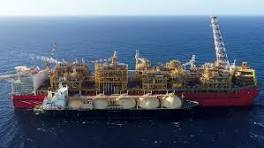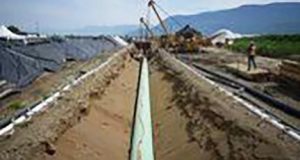By Matteo Cimellaro
Local Journalism Initiative Reporter
For some First Nations, the choice between economic self-sufficiency and environmental and climate concerns has arrived at a crossroads as the Coastal GasLink pipeline nears operation, critics say.
Coastal GasLink, the disputed pipeline opposed by Wet’suwet’en hereditary leadership, reached mechanical completion in November. It will soon carry millions of dollars worth of liquified natural gas
(LNG) to floating facilities on the northern coast of British Columbia for exports to Asia. First Nations are emerging as key players in the West Coast gas boom lauded by Ottawa and Victoria.
Floating LNG facilities are already proposed by the Nisga’a and Haisla Nations, while other nations are sitting on major prospective gas fields.
The coastal nations are counting on LNG to uplift their communities after 150 years of impoverishment and degraded social conditions unleashed by colonial policies and land dispossession.
However, they face criticism from environmentalists and other regional First Nations for the climate and environmental consequences of a massive expansion of new gas infrastructure.
On Monday, Shell Eastern Trading (Pte) Ltd., agreed to become the first purchaser of natural gas from Ksi Lisims LNG, a proposed project led by the Nisga’a Nation in northern British Columbia. The Singapore-based company hopes to purchase two million tonnes of LNG annually from Ksi Lisims, or one-sixth of its production. Ksi Lisims plans to begin exports in 2028.
Nisga’a joins the Haisla Nation, which is further along with its Cedar LNG facility that is being co-developed with Pembina Pipeline, a Canadian oil and gas company.
It’s essentially about becoming self-sufficient, Candice Wilson, environmental manager for Haisla First Nation, said in an interview.
“We can be self-governing, provide services on our own and not have the limitations of policy and regulation that the federal government implements.”
Millions of dollars of gas revenue carry the promise of independence for the First Nations, which have long been dependent on colonial governments in Victoria and Ottawa. Often, relationships with provinces and Ottawa can be fickle for First Nations since they can change with each passing budget or government. Economic independence could also give First Nations more power and influence with government officials.
Wilson said the “economic benefit would be very far-reaching.”
She sees the goal of the LNG facilities as economic reconciliation, a phrase gaining more traction in First Nations, provinces and Ottawa.
The definition is broad and encompassing and can span from inclusion in Canada’s resource economy to more ancestral economic activities and ecosystem revitalization.
Wilson’s definition includes all three through the First Nations Climate Initiative (FNCI), led by the Nisga’a, Haisla and three other First Nations. The initiative seeks to alleviate climate change and poverty, according to the organization’s website.
Part of the initiative’s climate plan is based on nature-based solutions, an umbrella term for funding ecosystem conservation and restoration through carbon credits. Haisla has already restored five streams in their territory and hopes salmon numbers will increase when the streams are fully rehabilitated, Wilson said.
The credits are purchased by the First-Nations-led LNG facilities, ostensibly to make them carbon neutral. The theory goes that carbon emitted by fossil fuel development can be mitigated by purchasing carbon credits in other projects that restore the environment’s carbon-storing capacity.
But carbon credits are often criticized as a way to extend the life of fossil fuels beyond the timeline that climate scientists warn will result in catastrophic tipping points.
Environmentalists and other regional First Nations poke holes in the initiative’s plan on the grounds that massively expanding gas infrastructure in the region will lead to a net increase in global heating and harm the local environment.
Glen Williams, president of the Gitanyow Hereditary Chiefs, whose nation is currently in a land dispute with Nisga’a, questions how LNG facilities can claim to be carbon neutral, citing that “there’s no real basis for that.”
“ Ksi Lisims is going to contribute to global warming, and it’s gonna be disastrous in the drought conditions that we’re experiencing now,” Williams said.
“It’s unfortunate that an alternative could not be found for the economic stability in their communities,” he added.
To the south, marine harvesters in Haida Gwaii told Canada’s National Observer last year that they feared the potential impact of a boom in tanker traffic on the coastal environment they depend on for harvesting and tourism.
“The impacts are cumulative, and each additional ship that crosses this region increases the pressure on Haida Gwaii,” Council of the Haida Nation President Gaagwiis (Jason Alsop) told Canada’s National Observer at the time.
John Young, B.C. transition analyst for the David Suzuki Foundation, said as a settler, it is inappropriate for him to suggest “how Indigenous Peoples should proceed, on LNG or anything else.”
However, from a climate science perspective, he worries gas development in the province will slow progress on Canada’s transition. He describes the situation using three L’s: gas locks in emissions, locks out renewables and locks up capital needed for a truly clean economy.
If all five proposed LNG projects on the West Coast are developed, they will produce around 30.3 megatonnes per year, blowing through the province’s 9.3-megatonne oil and gas industry emission target, Young said.
Then, there is the Montney Play, which sits on the territory of Blueberry River First Nation in B.C. The gas field is one of the largest in North America and one of the biggest carbon bombs in the world, meaning it would become Canada’s largest source of greenhouse gases and among the highest-emitting places globally.
Gas will eventually become a stranded asset in an electrified world, devaluing the LNG facilities operated by First Nations, Young warns.
Beyond markets, Young says the climate crisis is the biggest existential threat to humanity and must be curtailed, particularly by sidestepping a major gas boom.
But for some First Nations, who have survived the existential threat of colonialism since contact, the opportunity of gas promises the road to prosperity, wealth and influence, irrespective of Ottawa or Victoria.
“Beating climate change is all about having real dialogue and figuring out what the solutions are,” Alex Grzybowski, the facilitator of the First Nation Climate Initiative, said. “We don’t have all solutions, but we have some. We’re promoting them and trying to develop them.”
– With files from John Woodside
Matteo Cimellaro / Canada’s National Observer / Local Journalism Initiative/LJi is a federally funded program
 Aboriginal Business Magazine Your source for Aboriginal Business News
Aboriginal Business Magazine Your source for Aboriginal Business News




